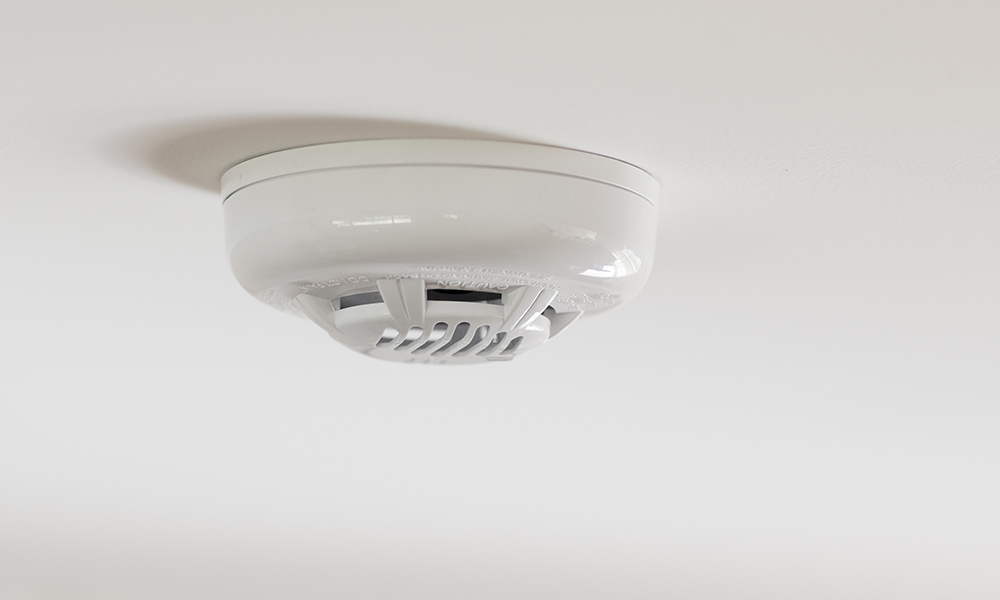Carbon monoxide (CO) detectors are made to measure levels of carbon monoxide over time and to sound when carbon monoxide levels become dangerous to the point where they could potentially cause poisoning.
There are several varieties of carbon monoxide detectors. Most incorporate one of the following detection mechanisms: a biomimetic sensor, electrochemical sensor, or a metal oxide semiconductor.
Here’s how each works:
- Biomimetic sensor: A special gel turns a different color when it comes in contact with carbon monoxide. The shift in color causes an alarm to go off. While this might be the most reliable type of alarm, it is more expensive and generally less common for typical household use. It is used most often in hospitals and hotels.
- Electrochemical sensor: This type of sensor consists of an electrochemical cell that contains two electrodes, a connecting wire, and an electrolyte like sulfuric acid. When unsafe levels of carbon monoxide cause a change in the electrical current, the alarm sounds. These types of sensors are now likely the most common types in the United States and Europe as they don’t require much power and have a lifespan of five years or more. The Vivint carbon monoxide alarm employs this type of sensor.
- Metal oxide semiconductor: Measuring resistance, small wires on a ceramic base are heated to measure carbon monoxide levels. Resistance is lowered when carbon monoxide is sensed, signaling for the alarm to sound. This type of detection equipment requires substantial power and is often less effective than the electrochemical sensor. It is thus less common now.
How do you set up a carbon monoxide detector?
Since your family’s safety is of utmost importance, it’s best to have a trained professional install your detector. Not only will they ensure it is installed correctly, but they’ll also do it quickly. Leave the hassle to the pros and focus on keeping your family protected from harmful carbon monoxide.
Where is the best place to install a carbon monoxide detector?
The NFPA (National Fire Protection Association) suggests positioning carbon monoxide detectors outside each bedroom, on each floor of the home, and in whichever locations required by local laws.

Why is carbon monoxide so dangerous?
Carbon monoxide is extremely dangerous. Why? Because carbon monoxide is not only toxic, but also tasteless, colorless, and odorless. Unlike a fire, there often are no concrete signs like smoke or heat. In other words, it’s virtually impossible to discover it without the right detector.
The original symptoms are shortness of breath and nausea, which can often be passed off as just a common sickness. Carbon monoxide poisoning, however, can lead to much more serious problems like suffocation and brain damage.
Carbon monoxide poisoning doesn't just affect people. Pets can also suffer from CO poisoning, leading to illness, internal damage, or even death.
What does a carbon monoxide detector do?
A carbon monoxide detector is designed to alert your family to deadly fumes that come as byproducts of fire and burning wood, gasoline, propane, natural gas, coal, and heating oil.
Several items within and without the home can cause carbon monoxide poisoning including water heaters, wood burning stoves, idling cars, clothes dryers, and water heaters.
How essential is a carbon monoxide detector for home safety?
A carbon monoxide detector is an extremely valuable element to include in your consideration of home safety products and alarms. Most people have fire alarms in their homes, but not as many have carbon monoxide detectors.
This is troublesome since carbon monoxide is so dangerous and almost impossible to detect without an alarm.
Connecting a carbon monoxide detector to an integrated smart home security system provides an extra level of security. If the carbon monoxide alarm sounds, you will be notified by your panel and smart home app, and our professional monitoring team can send help if needed. This means your home is protected whether you're home or not, which brings great peace of mind.
How do you get a carbon monoxide detector?
Make the small investment to have the extra security of knowing your family is safe and protected from carbon monoxide poisoning.
Contact Us















